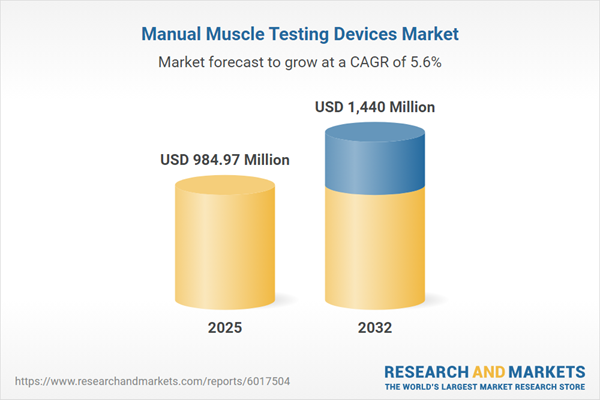Speak directly to the analyst to clarify any post sales queries you may have.
Manual muscle testing devices are playing an increasingly pivotal role in transforming modern healthcare, enabling clinicians and allied professionals to obtain precise, objective measurements for diagnostics, rehabilitation, and performance assessment. As demand intensifies for reliable, data-driven patient care, the manual muscle testing devices market is undergoing rapid innovation and strategic growth.
Market Snapshot: Manual Muscle Testing Devices Market Surge
The Manual Muscle Testing Devices Market grew from USD 932.39 million in 2024 to USD 984.97 million in 2025. Driven by robust demand for objective neuromuscular assessment, the sector is set to achieve a CAGR of 5.62%, ultimately projected to reach USD 1.44 billion by 2032. This pace reflects mounting adoption across clinical diagnostics, post-acute care, and sports science, with innovators delivering solutions that blend user-centric design, regulatory compliance, and advanced analytics.
Scope & Segmentation: Depth Across Products, Technology, and Geographies
- Product Types: Electronic dynamometers, handheld dynamometers, isokinetic dynamometers, and mechanical dynamometers. Each product category fulfills unique requirements for varying healthcare environments, addressing both advanced clinical diagnostics and budget-conscious facilities.
- End Users: Home care settings, hospitals, rehabilitation centers, research institutes, and sports clinics. These diverse segments represent the broadening reach of manual muscle testing devices from outpatient monitoring to specialized athletic performance optimization.
- Technologies: Electromagnetic, hydraulic, load cell, pneumatic, and strain gauge-based systems. Technological diversification meets specific performance, maintenance, and integration needs across stakeholder groups.
- Distribution Channels: Direct sales, distributors, online sales, and select retail partnerships. Distribution strategies vary by geography and target market, enabling both rapid procurement and tailored support for large accounts.
- Regional Coverage: Americas, Europe, Middle East, Africa, and Asia-Pacific. Detailed analysis spans established markets in North America and Western Europe to emerging adoption in Latin America, the Middle East, Africa, and Asia’s growth economies.
- Leading Companies: AMETEK, Inc.; JTECH Medical, Inc.; Hoggan Health Industries, Inc.; Biometrics Ltd.; Lafayette Instrument Company; RTI Electronics, Inc.; EvalTech, Inc.; Delsys, Inc.; Fabrication Enterprises, Inc.; Patterson Companies, Inc. Each contributes to category innovation, research collaboration, and market leadership.
Key Takeaways for Stakeholders
- Rapid technology integration is elevating manual muscle testing from basic strength evaluation to platforms that enable predictive analytics and remote monitoring through wireless connectivity.
- Manufacturers are enhancing device adaptability via modular hardware, user-friendly interfaces, and interoperability with electronic health records, ensuring seamless alignment with clinical workflows.
- Strategic alliances between device makers, software developers, and academic centers drive research advances and product differentiation, broadening the market's collaborative potential.
- Segment-specific needs are shaping development priorities, with portable devices gaining traction in home care and cost-effective settings, while high-precision systems serve specialized healthcare institutions and research labs.
- Region-based regulatory compliance and local assembly are essential for market entry and differentiation, especially in Asia-Pacific and EMEA, where demand patterns and infrastructure diversity vary widely.
Tariff Impact and Supply Chain Resilience
Recent tariffs introduced in the United States have influenced global sourcing, cost structures, and manufacturing footprint strategies. Many manufacturers are now prioritizing alternative suppliers in tariff-exempt regions and enhancing localized assembly capacity to counter import cost pressures. Strategies including material substitution, automated production, and procurement agility are strengthening the sector’s resilience and maintaining access for end users. These developments highlight the importance of adaptive planning in navigating ongoing trade and regulatory volatility.
Methodology & Data Sources
This analysis combines systematic secondary research, comprehensive primary interviews with experts including clinicians and industry leaders, and independent validation. Triangulation of data ensures insight accuracy, while diverse sources—peer-reviewed literature, regulatory filings, technical reports, and direct conversations—enhance credibility and depth.
Why This Report Matters
- Offers granular segmentation and actionable intelligence supporting investment, procurement, and product strategy decisions for senior leaders.
- Equips organizations to assess evolving technology and regulatory landscapes, benchmarking both market opportunities and competitive risks.
- Provides clarity on distribution models, regional trends, and innovation hubs, enabling tailored expansion and operational responses.
Conclusion
The manual muscle testing devices market is shaped by technological evolution, evolving clinical paradigms, and strategic realignment to supply chain shifts. Stakeholders equipped with this report are positioned to leverage both current opportunities and emerging trends for optimal business outcomes.
Additional Product Information:
- Purchase of this report includes 1 year online access with quarterly updates.
- This report can be updated on request. Please contact our Customer Experience team using the Ask a Question widget on our website.
Table of Contents
3. Executive Summary
4. Market Overview
7. Cumulative Impact of Artificial Intelligence 2025
Companies Mentioned
The companies profiled in this Manual Muscle Testing Devices market report include:- AMETEK, Inc.
- JTECH Medical, Inc.
- Hoggan Health Industries, Inc.
- Biometrics Ltd.
- Lafayette Instrument Company
- RTI Electronics, Inc.
- EvalTech, Inc.
- Delsys, Inc.
- Fabrication Enterprises, Inc.
- Patterson Companies, Inc.
Table Information
| Report Attribute | Details |
|---|---|
| No. of Pages | 181 |
| Published | November 2025 |
| Forecast Period | 2025 - 2032 |
| Estimated Market Value ( USD | $ 984.97 Million |
| Forecasted Market Value ( USD | $ 1440 Million |
| Compound Annual Growth Rate | 5.6% |
| Regions Covered | Global |
| No. of Companies Mentioned | 11 |









